教育技术学专业英语PPT课件
- 格式:ppt
- 大小:953.50 KB
- 文档页数:13
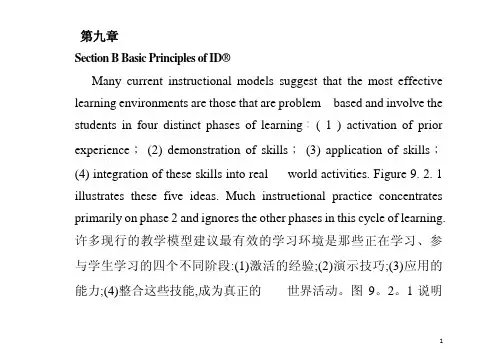
第九章Section B Basic Principles of ID®Many current instructional models suggest that the most effective learning environments are those that are problem—based and involve the students in four distinct phases of learning :(1)activation of prior experience;(2)demonstration of skills;(3)application of skills;(4)integration of these skills into real—world activities.Figure9.2.1 illustrates these five ideas.Much instruetional practice concentrates primarily on phase2and ignores the other phases in this cycle of learning.许多现行的教学模型建议最有效的学习环境是那些正在学习、参与学生学习的四个不同阶段:(1)激活的经验;(2)演示技巧;(3)应用的能力;(4)整合这些技能,成为真正的——世界活动。
图9。
2。
1说明了这些五的想法。
多instruetional实践集中主要在第二阶段,而忽略了其他方面在这个循环的学习。
At the too level.the instructional design prescriptions based on first principles are as follows ::(1〉Learning is facilitated when learners are engaged in solving real-world problems.在太水平。
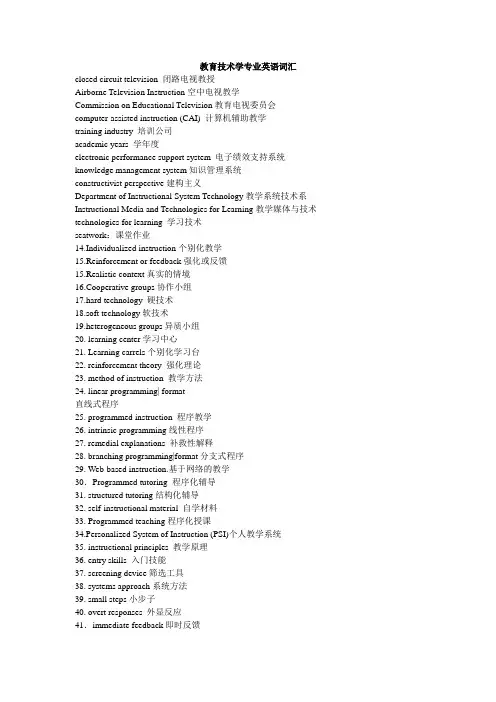
教育技术学专业英语词汇closed circuit television 闭路电视教授Airborne Television Instruction空中电视教学Commission on Educational Television教育电视委员会computer-assisted instruction (CAI) 计算机辅助教学training industry 培训公司academic years 学年度electronic performance support system 电子绩效支持系统knowledge management system知识管理系统constructivist perspective建构主义Department of Instructional System Technology教学系统技术系Instructional Media and Technologies for Learning教学媒体与技术technologies for learning 学习技术seatwork:课堂作业14.Individualized instruction个别化教学15.Reinforcement or feedback强化或反馈15.Realistic context真实的情境16.Cooperative groups协作小组17.hard technology 硬技术18.soft technology软技术19.heterogeneous groups异质小组20. learning center学习中心21. Learning carrels个别化学习台22. reinforcement theory 强化理论23. method of instruction 教学方法24. linear programming| format直线式程序25. programmed instruction 程序教学26. intrinsic programming线性程序27. remedial explanations 补救性解释28. branching programming|format分支式程序29. Web-based instruction.基于网络的教学30.Programmed tutoring 程序化辅导31. structured tutoring结构化辅导32. self-instructional material 自学材料33. Programmed teaching程序化授课34.Personalized System of Instruction (PSI)个人教学系统35. instructional principles 教学原理36. entry skills 入门技能37. screening device筛选工具38. systems approach系统方法39. small steps小步子40. overt responses 外显反应41.immediate feedback即时反馈42. empirical approach 经验主义方法43. formative evaluation形成性评价44.summative evaluation 总结性评价45. instructional design models教学设计模式46. behavioral objectives行为目标47. self-instructional system 个别化教学系统48. cognitive domain 认知领域49. norm-referenced 常模参照测验50.criterion-referenced 标准参照测验51.outcomes-verbal information言语信息52. intellectual skills智力技能53. psychomotor skills动作技能54. cognitive strategies认知策络55. events of instruction教学事件56cognitive psychology 认知心理学57. computer-based instruction基于计算机的教学58. front-end analysis前段分析59.Metacognition元认知60. cognitive awareness认知知觉61. metacognitive strategies 元认知策络62.Metamerory元记忆63.memory strategies 记忆策略64.Metacomprehension元理解65. Schema training图式训练66. multimedia learning environments 多媒体学习环境67. embedded information management信息管理68. database analysis数据库分析69. multimedia design多媒体设计70. Multimedia computer systems 多媒体计算机系统71. videodisc player 光盘播放器72. compression technology压缩技术73. analog formats 模拟格式74.Compression software压缩软件75. Musical Instrument Digital Interface (MIDI). 音乐设备数字接口Speech synthesisi 语音合成Virtual reality虚拟现实Cognitive awarenesss 认知知觉Compression techonology 压缩技术Analog formats 模拟形式OHP(overhead projector投影仪)OHT(overhead transparency 投影片)Videotape录像带CLEs(constuctive learning environmet)建构主义学习环境Knowledge construction知识建构Meaning learning 有意义学习Activity theory 持续活动论COLs(communities of leaners )学习者共同体Ph ysical Capital 物质资本Human capital人力资本Performance technology 绩效技术In the same wein 同样的On-demand 随机的Stand-alone 独立的HPT(human performance technology)人类绩效技术Behavioral and cognitive specialists行为和认知心理专家Human resouece specilists人力资源专家Integrated learning system 综合学习系统EPSS electronic performance support system 电子绩效支持系统Expert system 专家系统Informance base 信息库Embedded coaching 嵌入式指导Expert advisor专家顾问Leaning experience 学习经历Knowledge assets知识资产Performance problems绩效问题Audio teleconferencing 音频会议系统Audiographics conferencing 音频图形会议系统Videoconferencing 视频会议系统High-resolution 高分辨率Full-color真彩色Ad hoc 特定,专门,临时IST (interactive instruction television )交互式电视系统Interactive video and videotext 交互式视频显示技术Correspondence education函授教育Advance organize 先行组织者Inquiry learning 提问式学习,问究学习Progressive discourse 渐进式交流Situation cognition情景认知Instructional model教学模型Vocational classe职业课程systems approach 系统方法desired learning outcome期望的到的结果。
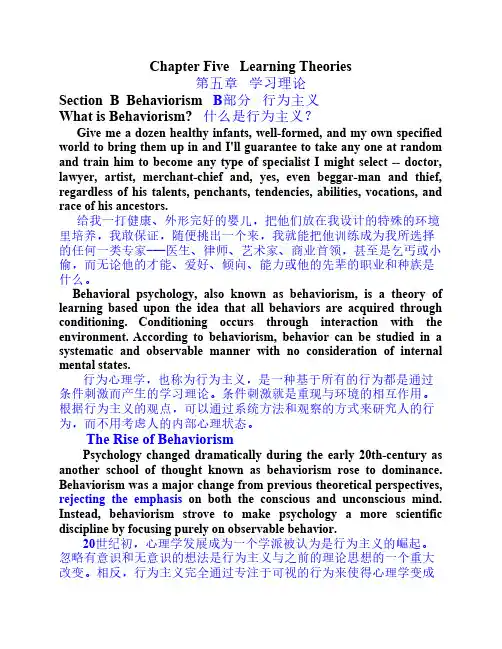
Chapter Five Learning Theories第五章学习理论Section B Behaviorism B部分行为主义What is Behaviorism? 什么是行为主义?Give me a dozen healthy infants, well-formed, and my own specified world to bring them up in and I'll guarantee to take any one at random and train him to become any type of specialist I might select -- doctor, lawyer, artist, merchant-chief and, yes, even beggar-man and thief, regardless of his talents, penchants, tendencies, abilities, vocations, and race of his ancestors.给我一打健康、外形完好的婴儿,把他们放在我设计的特殊的环境里培养,我敢保证,随便挑出一个来,我就能把他训练成为我所选择的任何一类专家---医生、律师、艺术家、商业首领,甚至是乞丐或小偷,而无论他的才能、爱好、倾向、能力或他的先辈的职业和种族是什么。
Behavioral psychology, also known as behaviorism, is a theory of learning based upon the idea that all behaviors are acquired through conditioning.Conditioning occurs through interaction with the environment.According to behaviorism, behavior can be studied in a systematic and observable manner with no consideration of internal mental states.行为心理学,也称为行为主义,是一种基于所有的行为都是通过条件刺激而产生的学习理论。
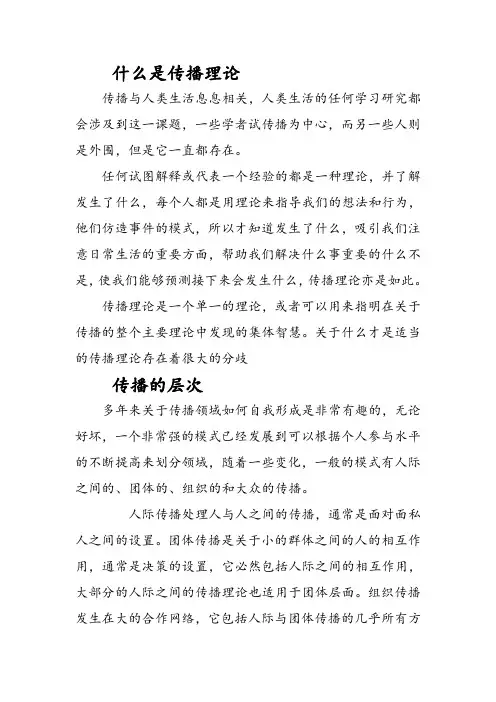
什么是传播理论传播与人类生活息息相关,人类生活的任何学习研究都会涉及到这一课题,一些学者试传播为中心,而另一些人则是外围,但是它一直都存在。
任何试图解释或代表一个经验的都是一种理论,并了解发生了什么,每个人都是用理论来指导我们的想法和行为,他们仿造事件的模式,所以才知道发生了什么,吸引我们注意日常生活的重要方面,帮助我们解决什么事重要的什么不是,使我们能够预测接下来会发生什么,传播理论亦是如此。
传播理论是一个单一的理论,或者可以用来指明在关于传播的整个主要理论中发现的集体智慧。
关于什么才是适当的传播理论存在着很大的分歧传播的层次多年来关于传播领域如何自我形成是非常有趣的,无论好坏,一个非常强的模式已经发展到可以根据个人参与水平的不断提高来划分领域,随着一些变化,一般的模式有人际之间的、团体的、组织的和大众的传播。
人际传播处理人与人之间的传播,通常是面对面私人之间的设置。
团体传播是关于小的群体之间的人的相互作用,通常是决策的设置,它必然包括人际之间的相互作用,大部分的人际之间的传播理论也适用于团体层面。
组织传播发生在大的合作网络,它包括人际与团体传播的几乎所有方面,它包括的课题如结构、组织的功能、人际关系、沟通和组织的过程与组织文化。
最后,通常大众传播通过调解来处理公共传播,在大众传播过程中涉及许多方面的人际的、团体的和组织的传播。
核心传播理论你会遇到许多关于处理传播的特殊方面的理论。
一些理论则解释了传播所独有的层面。
反之,其他的理论则关注了所有传播所共有的常规概念和一般过程。
我们就可以传播的一般处理方法为核心传播理论。
核心理论是特别有意义的,因为它帮助我们在大体上理解了传播。
不论传播在什么时候发生,核心理论都为传播活动的过程提供了见解。
以下的列表列举了核心传播理论的典型要素。
第一,核心理论告诉了我们传播的发展。
第二,核心理论强调了意义的产生与诠释。
第三,核心理论讨论信息结构,亦即信息的元素的组成成分,包括语言、文字与非语文的文本。

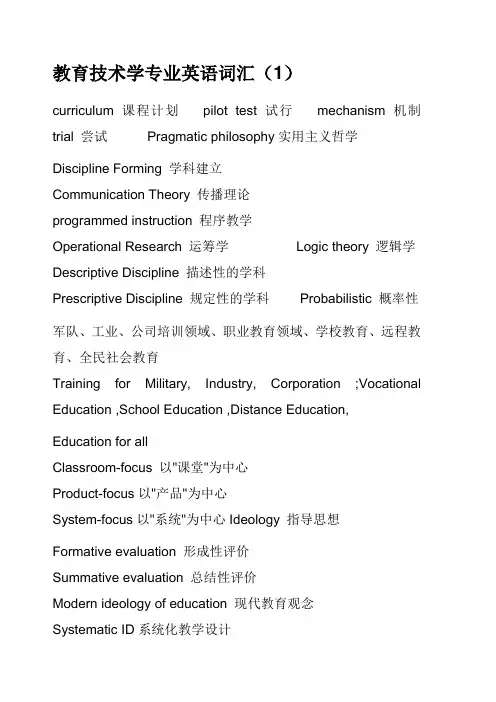
教育技术学专业英语词汇(1)curriculum 课程计划pilot test 试行mechanism 机制trial 尝试Pragmatic philosophy实用主义哲学Discipline Forming 学科建立Communication Theory 传播理论programmed instruction 程序教学Operational Research 运筹学Logic theory 逻辑学Descriptive Discipline 描述性的学科Prescriptive Discipline 规定性的学科Probabilistic 概率性军队、工业、公司培训领域、职业教育领域、学校教育、远程教育、全民社会教育Training for Military, Industry, Corporation ;Vocational Education ,School Education ,Distance Education,Education for allClassroom-focus 以"课堂"为中心Product-focus以"产品"为中心System-focus以"系统"为中心Ideology 指导思想Formative evaluation 形成性评价Summative evaluation 总结性评价Modern ideology of education 现代教育观念Systematic ID系统化教学设计Systemic ID 整体化教学设计Didactics, Instructional Theory and ID 教学论、教学理论与教学设计manifest 说明Random access learning 随机进入学习Situated learning 情境学习Anchored learning 锚定式情境学习教学论--哲学取向philosophy-oriented探求规律并解释现象教学理论--心理学取向psychology-oriented --- 探求在一定情境下,为达到目的,而采用的总体方法教学(设计)理论sound 丰富的,合理的,充分的。
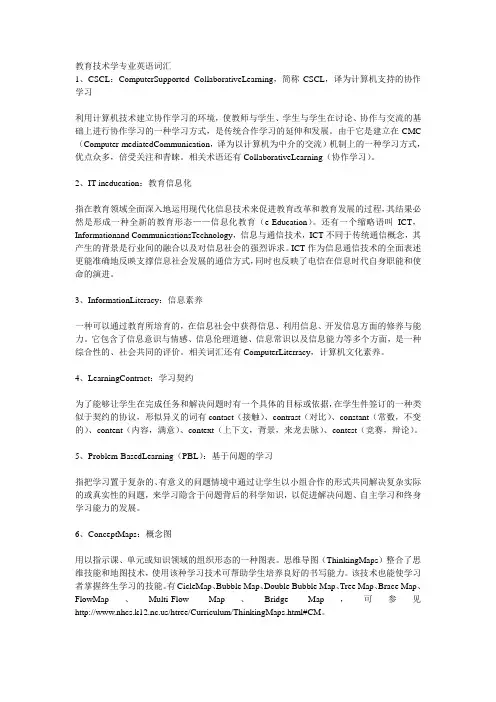
教育技术学专业英语词汇1、CSCL:ComputerSupported CollaborativeLearning,简称CSCL,译为计算机支持的协作学习利用计算机技术建立协作学习的环境,使教师与学生、学生与学生在讨论、协作与交流的基础上进行协作学习的一种学习方式,是传统合作学习的延伸和发展。
由于它是建立在CMC (Computer-mediatedCommunication,译为以计算机为中介的交流)机制上的一种学习方式,优点众多,倍受关注和青睐。
相关术语还有CollaborativeLearning(协作学习)。
2、IT ineducation:教育信息化指在教育领域全面深入地运用现代化信息技术来促进教育改革和教育发展的过程,其结果必然是形成一种全新的教育形态——信息化教育(e-Education)。
还有一个缩略语叫ICT,Informationand CommunicationsTechnology,信息与通信技术,ICT不同于传统通信概念,其产生的背景是行业间的融合以及对信息社会的强烈诉求。
ICT作为信息通信技术的全面表述更能准确地反映支撑信息社会发展的通信方式,同时也反映了电信在信息时代自身职能和使命的演进。
3、InformationLiteracy:信息素养一种可以通过教育所培育的,在信息社会中获得信息、利用信息、开发信息方面的修养与能力。
它包含了信息意识与情感、信息伦理道德、信息常识以及信息能力等多个方面,是一种综合性的、社会共同的评价。
相关词汇还有ComputerLiterracy,计算机文化素养。
4、LearningContract:学习契约为了能够让学生在完成任务和解决问题时有一个具体的目标或依据,在学生件签订的一种类似于契约的协议,形似异义的词有contact(接触)、contrast(对比)、constant(常数,不变的)、content(内容,满意)、context(上下文,背景,来龙去脉)、contest(竞赛,辩论)。
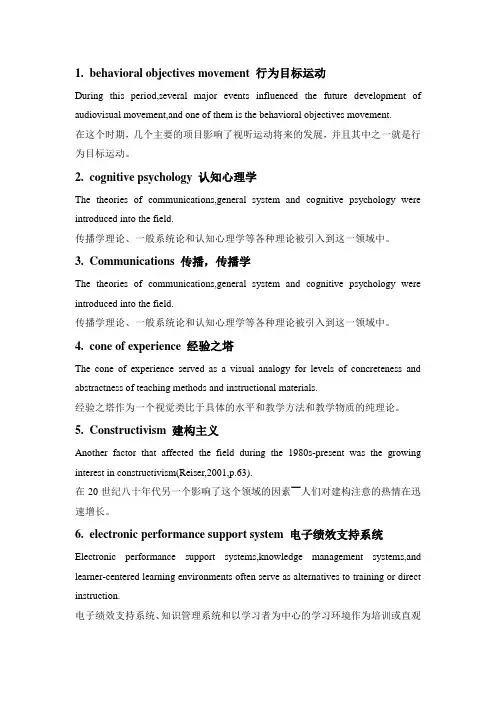
1. behavioral objectives movement 行为目标运动During this period,several major events influenced the future development of audiovisual movement,and one of them is the behavioral objectives movement.在这个时期,几个主要的项目影响了视听运动将来的发展,并且其中之一就是行为目标运动。
2. cognitive psychology 认知心理学The theories of communications,general system and cognitive psychology were introduced into the field.传播学理论、一般系统论和认知心理学等各种理论被引入到这一领域中。
3. Communications 传播,传播学The theories of communications,general system and cognitive psychology were introduced into the field.传播学理论、一般系统论和认知心理学等各种理论被引入到这一领域中。
4. cone of experience 经验之塔The cone of experience served as a visual analogy for levels of concreteness and abstractness of teaching methods and instructional materials.经验之塔作为一个视觉类比于具体的水平和教学方法和教学物质的纯理论。
5. Constructivism 建构主义Another factor that affected the field during the 1980s-present was the growing interest in constructivism(Reiser,2001,p.63).在20世纪八十年代另一个影响了这个领域的因素▔人们对建构注意的热情在迅速增长。
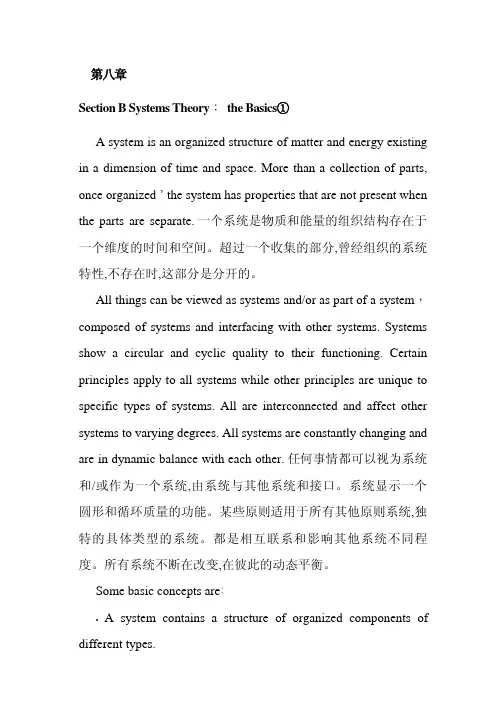
第八章Section B Systems Theory:the Basics①A system is an organized structure of matter and energy existing in a dimension of time and space.More than a collection of parts, once organized’the system has properties that are not present when the parts are separate.一个系统是物质和能量的组织结构存在于一个维度的时间和空间。
超过一个收集的部分,曾经组织的系统特性,不存在时,这部分是分开的。
All things can be viewed as systems and/or as part of a system,composed of systems and interfacing with other systems.Systems show a circular and cyclic quality to their functioning.Certain principles apply to all systems while other principles are unique to specific types of systems.All are interconnected and affect other systems to varying degrees.All systems are constantly changing and are in dynamic balance with each other.任何事情都可以视为系统和/或作为一个系统,由系统与其他系统和接口。
系统显示一个圆形和循环质量的功能。
某些原则适用于所有其他原则系统,独特的具体类型的系统。
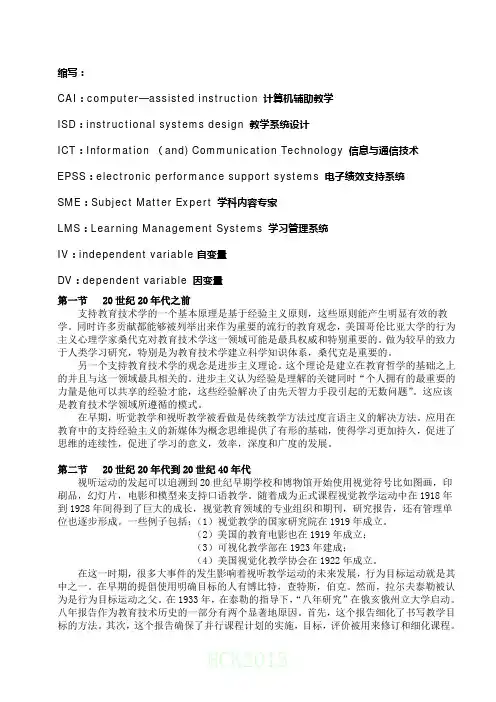
缩写:CAI:computer—assisted instruction 计算机辅助教学ISD:instructional systems design 教学系统设计ICT:Information (and) Communication Technology 信息与通信技术EPSS:electronic performance support systems 电子绩效支持系统SME:Subject Matter Expert 学科内容专家LMS:Learning Management Systems 学习管理系统IV:independent variable自变量DV:dependent variable 因变量第一节 20世纪20年代之前支持教育技术学的一个基本原理是基于经验主义原则,这些原则能产生明显有效的教学。
同时许多贡献都能够被列举出来作为重要的流行的教育观念,美国哥伦比亚大学的行为主义心理学家桑代克对教育技术学这一领域可能是最具权威和特别重要的。
做为较早的致力于人类学习研究,特别是为教育技术学建立科学知识体系,桑代克是重要的。
另一个支持教育技术学的观念是进步主义理论。
这个理论是建立在教育哲学的基础之上的并且与这一领域最具相关的。
进步主义认为经验是理解的关键同时“个人拥有的最重要的力量是他可以共享的经验才能,这些经验解决了由先天智力手段引起的无数问题”。
这应该是教育技术学领域所遵循的模式。
在早期,听觉教学和视听教学被看做是传统教学方法过度言语主义的解决方法。
应用在教育中的支持经验主义的新媒体为概念思维提供了有形的基础,使得学习更加持久,促进了思维的连续性,促进了学习的意义,效率,深度和广度的发展。
第二节 20世纪20年代到20世纪40年代视听运动的发起可以追溯到20世纪早期学校和博物馆开始使用视觉符号比如图画,印刷品,幻灯片,电影和模型来支持口语教学。
随着成为正式课程视觉教学运动中在1918年到1928年间得到了巨大的成长,视觉教育领域的专业组织和期刊,研究报告,还有管理单位也逐步形成。
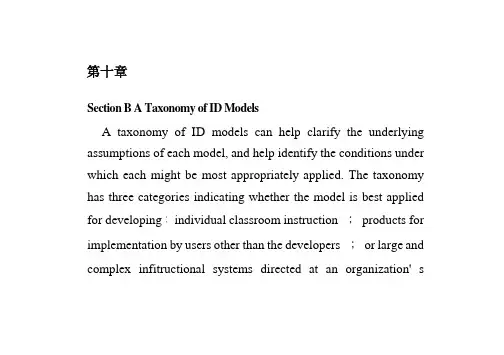
PEET专业词汇I、vocabulary1、educational technology n 教育技术2、Event of instruction n 教学事件3、novice n 初学者,新手4、Andragogy n 成人教育学5、Constructivism Learning Theory 建构主义学习理论6、Educational Objective 教育目标7、Electronic performance System 电子绩效系统8、receiver n 接收器9、channel n 频道、信道、通道10、Core communication theory 核心传播理论11、cognitive science 认知科学12、diagram n 图表13、event instruction 教学事件14、hypothesize n 假设15、psychotherapy n 心理疗法16、Chaos theory 混沌理论17、natural science 自然科学18、organizational theory 组织理论19、system dynamic 系统动理论20、internal learning condition 内在学习理论21、external learning condition 外在学习理论22、system thinking 系统思考23、category of learning outcome 学习结果分类24、cognitive information process theory 认知信息加工理论25、discovery learning 发现学习26、thinning v 细化、解说27、mass communication 大众传播28、group communication 群体传播29、learning condition 学习环境30、instructional strategy 教学策略31、metacognition n 元认知32、interpersonal communication 人际传播33、individual learning 个性化学习34、information process theory 信息加工理论35、expert instruction 专家教学36、Hypermedia program 超媒体程序37、Multistore theory of memory多重存储记忆理论38、Classification n 分类法39、interactional dynamics互动动态40、progressive education 进步主义教育41、social learning theory 社会学习理论42、performance potential 绩效贤能43、encode n 编码44、decode n 解码45、transmitter n 传送者、传达人46、program instruction 程序教学47、level of cognitive performance 认知行为水平48、Bluetooth Wireless Technology 蓝牙无线技术49、cable television system 有线电视系统50、CD==Compact Disc 光盘51、DVD==Digital Video Disc 数字化视频光盘52、optic fiber transmission 光纤传输53、optic fiber 光纤54、microprocessor n 微处理55、satellite broadcast 卫星广播56、video cassette recorder 录像机57、advanced wireless device 高级无线设备58、artificial intelligence 人工智能59、artificial reality 人工限时60、computer simulation 计算机仿真61、CD-Rom==compact disk road only memory 光盘只读存储器62、computer-mediated communication 计算机媒介沟通63、cyber space 虚拟空间64、data glove 数据手套65、digital recorder 数字录像机66、interactive TV 互动电视67、Internet relay 网络聊天软件68、joystick n 操纵杆69、LCD: Liquid Crystal Display 液晶显示屏70、multimedia personal computer 个人多媒体计算机71、multiple-user dialogue 多人对话72、natural language processing 自然语言处理73、network information retrieval 网络信息搜寻系统74、Peripheral Controller Interconnect互联外围设备75、Neural network 神经中枢网络76、robotics n 机器人技术77、User Network 用户网78、wide area information server 广域信息服务器79、personal area network 个人无线局域网80、attribute of media 媒体特征81、correspondence course 函授课程82、host n 主机83、mainframe 大型机84、no significant different 无显著差异85、the great media debate 媒体大争论86、videodisk n 视盘87、analysis of learning goals 学习目标分析88、analysis of learning needs 学习需求分析89、anchor point 锚点90、accessment评估91、context n 上下文92、delivery system 传递系统93、evaluation instrument 评价工具94、go oriented 目标导向95、human resource 人力资源96、instruction situation 教学情况97、instructional activities 教学活动98、instructional design 教学设计99、instructional development 教学开发100、instructional material 教学材料101、instructional model 教学模型102、instructional science 教学科学103、instructional strategy 教学策略104、instructional system design 教学系统设计105、instructional theory 教学理论106、learning activities 学习活动107、learning environment 学习环境108、learning experience 学习经验109、learning strategy 学习策略110、learning theory 学习理论111、micro level 微观水平112、organization behavior 组织行为113、performance support 绩效支持114、prior experience 先前经验115、problem determination问题确定116、problem based 基于问题的117、stated objective 既定的目标118、team effort 团队协作119、event of instruction 教学事件120、formative evaluation 形成性评价121、summative evaluation 总结性评价122、automatic instruction design system 教学自动化学习系统123、information management 信息管理124、Knowledge Management 知识管理125、web based course management 基于网络的课程管理126、curriculum n 课程计划127、pilot test 试行128、mechanism n 机制129、trial v 尝试130、Pragmatic philosophy实用主义哲学131、Discipline Forming 学科建立132、Communication Theory 传播理论133、programmed instruction 程序教学134、Operational Research 运筹学135、Logic theory 逻辑学136、Descriptive Discipline 描述性的学科137、Prescriptive Discipline 规定性的学科138、Probabilistic n 概率性139、Training for Military军队140、Industry 工业141、Corporation 公司142、Vocational Education 职业领域教育143、School Education 学校教育145、Distance Education 远程教育146、Education for all 全民社会教育147、Classroom-focus 以"课堂"为中心148、Product-focus以"产品"为中心149、System-focus以"系统"为中心150、Ideology 指导思想151、Modern ideology of education 现代教育观念152、Systematic ID 系统化教学设计153、Systemic ID 整体化教学设计154、Didactics n教学论155、Instructional Theory and ID 教学理论与教学设计156、Piaget 皮亚杰157、cognitive-development theory 认知发展说158、Assimilation n 同化159、Accommodation n 顺应160、Equilibration n 平衡161、Schema n 图式162、Ec lecticism n 折衷学派163、Learning Psychology 学习理论164、Humanistic Psychology 人本主义心理学165、Acceptance of a value 价值的接受166、Preference for a value 对某一价值的偏好167、Commitment n 信奉168、Conceptualization of a value 价值概念化169、Organization of a value system 价值体系的组织170、Generalized set 泛化心向171、Characterization 性格化172、Howard Gardner 加德纳173、Multi-intelligence n 多元智能174、Verbal-linguistic intelligence 语言智能175、Logical-mathematical intelligence 数学逻辑智能176、Visual-spatial intelligence 空间智能177、Musical-rhythmic intelligence 音乐智能178、Bodily-kinesthetic intelligence 身体运动智能179、Interpersonal intelligence 人际关系智能180、Intrapersonal intelligence 自我认识智能181、Naturalist intelligence 自然智能182、Audience n 对象183、Behavior n 行为184、Condition n 条件185、Degree n 标准186、Norm-referenced n 常模参照评定187、Criterion-referenced n 标准参照评定188、Curriculum for a program 课程计划189、courses n 课程190、courseware n 课件191、units n 单元192、lessons or topics n 课193、advanced organizer 先行组织者194、Perception stage 认知阶段195、Part skills practice stage 分解阶段196、Total skill Coherently practice stage 定位阶段(连贯动作阶段)197、UC: Ubiquitous Computing 泛在计算198、Evaluation instrument developing 评价工具的编制199、Adversary Model 对手模式200、Responsive Model 应答模式201、meta-Evaluation 再评价202、the null curriculum 空无课程203、Expressive Objectives 表现性目标204、Interview v 访谈205、Questionaire n 问卷206、Observation n 观察207、Check-list 核对观察表208、manifest n 说明209、Random access learning 随机进入学习210、Situated learning 情境学习211、Anchored learning 锚定式情境学习。
learning and improving performance by creating、using、and managing appropriate technological processes and resources.(教育技术是通过创造、使用和管理适当的技术的过程和资源,以促进学习和提高绩效的研究和符合伦理道德的实践。
)2、三个媒体的研究目标:There are three major objectives of mediaresearch :(1)obtain knowledge about the educational or instructional effectiveness of a chosen medium;(2)increase understanding of how media and technology function and what psychological effects they have on a learner;(3)improve the practice of education through the provision and evaluation of better materials,media,procedures and technologies。
(有三个主要目标媒体研究:(1)获得知识的教育和教学的有效性所选择的媒介;(2)增加的了解媒体和技术功能和心理影响他们对学习者;(3)改进教育的实践和评估通过提供更好的材料、媒体、程序和技术。
)3、行为主义:Behavioral psychology,also known as behaviorism,is a theoryof learning based upon the idea that all behaviors are acquired through conditioning. Conditioning occurs through interaction with the environment. According to behaviorism,behavior can be studied in a systematic and observable manner with no consideration of internal mental states。
教育技术学专业英语词汇1. curriculum 课程计划2.pilot test 试行3. mechanism 机制4. Communication Theory 传播理论5.programmed instruction 程序教学6.Audiovisual communication 视听传播7.trial 尝试8.Formative evaluation 形成性评价9. Probabilistic 概率性10.Classroom-focus 以"课堂"为中心11.task analysis 任务分析12.verbalism 言语主义13.instructional systems d esign教学系统设计14.instructional technol ogy 教育技术15.performance 绩效16.utilization 利用17.digest 文摘18.syndication 聚合19.peotential 潜能ponent 元素21.stimuli 刺激22.encoding 编码23.Situated learning 情境学习24.advanced organizer 先行组织者25.25.Situated learning 情境学习26.Rand om access learning 随机进入学习27.Anchored learning 锚定式情境学习28.cognitive-d evel opment theory认知发展说29.Learning Psychology 学习理论30.Verbal-linguistic intelligence 语言智能31.Audience对象32.Behavior行为33.Condition条件34.Degree标准35.courses 课程36.36.Perception stage认知阶段rmation processing theory 信息加工理论38.Expressive Objectives 表现性目标puter Supported Collaborative Learning 计算机支持的协作学习40.Evaluation instrument d eveloping 评价工具的编制41.elaboration 细化42.metacognition 元认知43.retrieval 重视44.schema 图式45.channel 信道46.interactional dynamics互动动态47. 47.interpersonal communication 人际传播48. 48.signal 信号49.transmitter 传送者50.mass communication 大众传播51. 51.internal and external learning conditions 学习的内外部条件cational objective 教育目标53.53.electronic support system 电子支持系统54.54.event of instruction 教学事件55.expert instruction 专家教学56. 56.individualized learning 个性化学习57.57.intellectual skill 智慧技能58.learning theorist 学习理论家59.level of cognitive performance 认知行为水平60.Responsive Mod el 应答模式61.the null curriculum 空无课程62.Collaborative Learning协作学习63.IT in education教育信息化rmation and Communications Technol ogy信息与通信技术rmation Literacy 信息素养puter Literracy 计算机文化素养67.Learning Contract 学习契约68.Problem-Based Learning(PBL)基于问题的学习69.verbal information 言语信息70.spyware 间谍软件71.motion 电影pact Disk 光盘73.MTV 音乐电视74.satellite broad cast 卫星广播75.World Wid e Web 万维网76.76.microprocessor 微处理器77.cabl e television systems 有线电视系统78.fiber-optics transmission 光纤传输79.artificial reality 人工现实80.Artificial Intelligence 人工智能81.fiber 光纤82.keyboard 键盘83.mobile phone 移动电话84.virtual reality 虚拟现实85.wireless personal area network 个人无线局域网puter-Mediated Communication 计算机媒介沟通87.Concept Maps 概念图88.Thinking Maps思维导图89.integration 整合90.Performance Assessment 绩效评估91.91.mainframe 主机92.ved eodisk 视盘93.attribute of media 媒体特性94. 94.correspond ence 函授课程95.E-learning Portfolio 电子学档96.tacit knowledge 隐性知识97.explict knowledge显性知识98.Knowledge management 知识管理99.Knowledge Evolution Theory知识进化理论100. evaluation instrument 评价工具101. anchor point 锚点102. instructional material 教学材料103. learning experience 学习体验104. organizational behavior 组织行为105. performance support 绩效支持106. specialized 专用的107. systematic 系统的108. stated objective 既定的目标109. Blend ed learning 混合学习110. Virtual Learning Companion System 虚拟学伴系统111. Integrated Ware 积件112. Group Ware 群件113. Imagination 构想性114. summative evaluation 总结性评价115. Authentic Assessment真实性评价116. Scaffold Learning “支架式”学习117. knowledge object 知识对象118. AID systems 教学设计自动化系统119. analysis phase 分析阶段120. d elivery d omain 传送领域121. instructional d elivery 教学传递122. knowledge management system 知识管理系统123. Automated Instructional Design 自动化教学设计124. information explosion 信息爆炸125. Information Age 信息时代126. self-managed 自我管理127. well-trained 受过良好培训的128. E-learning 数字化学习129. WebQuest 网络探究学习130. experimental group 实验组131. case study 案例研究132. behavioral 行为的133. cognitive 认知的134. subject matter 主题135. postmod ern 后现代的136. hypothesis 假设137. holistic 整体的138. illogical 不合逻辑的139. complexity and interd epend ence 复杂性和相互依赖性140. receiver 接受者141. andragogy 成人教育学142. information-processing theory 信息加工理论143. retrieval 重现144. sensory 感觉器官145. slid e 幻灯片146. taxonomy 分类法147. transfer 迁移148. objectivism 客观主义149. research and d evelopment 研究与开发150. communication 传播.。